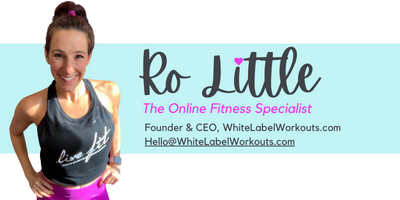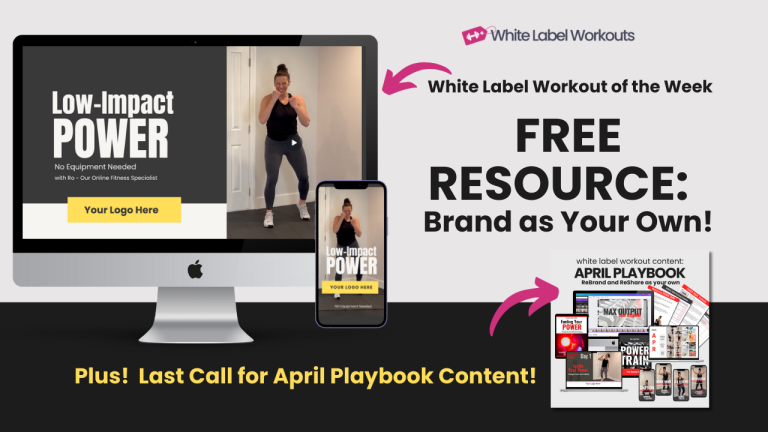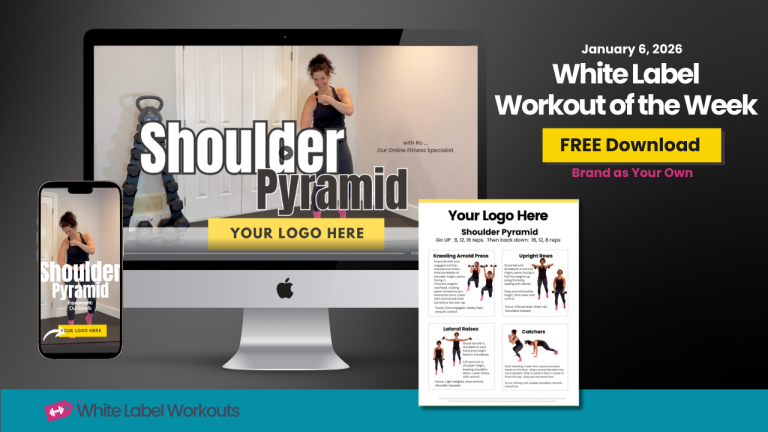What is the BEST exercise when we talk about building MUSCLE GROWTH & STRENGTH? The SQUAT, of course! 🍑💪
Note: This is a FREE White Label Coach Resource – scroll down for your editable White Label Links to rebrand this content to your business …
Our theme this week on WhiteLabelWorkouts.com is all about GROWTH. Growing PHYSICALLY – Growing MENTALLY – Growing PROFESSIONALLY.
If you’ve been hangin’ with me for a while, you’ll probably notice things look a little different around the website here. We’re in the middle of spring cleaning & restructuring – getting ready for a new level of service here at WhiteLabelWorkouts.com – we are definitely GROWING & BOOMING – and things are getting pretty exciting around here!
Have a look around the new site – and let me know what you think, k? I love your feedback!
Becuase I’m in FULL ON GROWTH mode here on the site, I am super inspired to help YOU GROW too! That’s why this week’s focus is GROWTH 💪
We chatted the other day in my TRAINER TIP post about building muscle – and the 2 different focuses. Building muscle growth in size (hypertrophy) and building muscle strength. It’s important to know the goals of your clients so that you can appropriately program for them.
🔗 Read the full post on my Trainer Tip of Building Muscle Mastery here >
Okie – so now let’s dive into the squat-sational world of hypertrophy! 🍑💪
If you’re looking to pump up those muscles and help your clients achieve their gains, then you’re in the right place! Today, we’re breaking down why squats are the perfect exercise for hypertrophy, sharing coaching cues, variations, common mistakes to avoid, and more. So grab a seat (or better yet, stand up!) and let’s get squatting!
Check out the SQUAT EXPLAINER video :
First things first, let’s talk about why squats are the holy grail of hypertrophy:
Muscle Activation: Squats engage multiple muscle groups simultaneously, including the quadriceps, hamstrings, glutes, and even the core and lower back. That means you’re getting a whole lot of bang for your buck with each rep!
Progressive Overload: Whether you’re using a barbell, dumbbells, or just your body weight, squats are highly adaptable to progressive overload. You can increase the resistance, adjust the depth, or vary the tempo to keep those muscles guessing and growing.
Functional Strength: As a compound movement pattern, squats mimic real-life activities like sitting down and standing up. By mastering the squat, you’re not just building muscle – you’re also improving functional strength and stability.
Hormonal Response: Squats have been shown to elicit a significant hormonal response, including increased secretion of growth hormone and testosterone. These hormones play a crucial role in muscle repair and growth, making squats a powerhouse for hypertrophy.
Now that we’ve covered why squats reign supreme, let’s dive into some coaching tips to help you and your clients maximize those gains!
How-To: Coaching Cues for Perfect Squats
Feet Placement: Start with feet shoulder-width apart or slightly wider, toes pointing slightly outward.
Bracing the Core: Engage the core by drawing the navel in towards the spine to maintain a stable trunk throughout the movement.
Hips Back, Knees Out: Initiate the movement by pushing the hips back and down, keeping the knees in line with the toes.
Depth: Aim to squat down until your thighs are parallel to the ground or slightly below, maintaining a neutral spine throughout.
Drive Through the Heels: Push through the heels to stand back up, squeezing the glutes at the top of the movement.
Variations to Spice Things Up
There are dozens of squat variations you can do – with a whole assortment of equipment from bodyweight, to dumbbells, to barbell, to resistance bands and more!
Barbell Back Squat: The classic squat variation, performed with a barbell resting on the upper back.
Dumbbell Goblet Squat: Hold a dumbbell vertically at chest level, squatting down while keeping the elbows close to the body.
Split Squat: Step one foot back onto a bench or platform, lowering the back knee towards the ground while keeping the front knee aligned with the ankle.
Jump Squats: Add a plyometric element by exploding upwards from the bottom of the squat, landing softly and immediately transitioning into the next rep.
Common Mistakes to Avoid
Poor Form: Keep an eye on proper form throughout the movement, avoiding rounding of the back or collapsing of the knees inward.
Not Going Deep Enough: Ensure that you’re reaching adequate depth with each squat, aiming to break parallel to fully engage the muscles.
Overloading Too Soon: Start with a weight that allows for proper form and gradually increase the resistance over time to avoid injury.
💡 ReBrand & ReShare The SQUAT Exercise Explainer [FREE Coach Resource!] 🚀💥
Smash those links below to be taken to CANVA where you can edit away! Drop in your own logo, adjust any styling to match your brand, and share!
🔗 Edit the SQUAT Explainer IMAGE >
🔗 Edit the SQUAT Explainer HORIZONTAL Video >
🔗 Edit the SQUAT Explainer VERTICAL Video >
💡 Oh and hey – check back tomorrow! I’ll be featuring SQUATS in this week’s white label Workout of the Week: Makin’ GAINZ! Lower Focus Circuit
🍑💪 Remember, mastering the squat takes time and practice, so be patient and stay consistent. Your clients will thank you for helping them achieve those squat-tastic gains!
Don’t hesitate to reach out if you have any questions – I’m here to help you succeed! 📩 Let’s crush those fitness & business goals together!
Stay AWESOME!
Xoxo ~ Ro ~ Your Online Fitness Specialist




